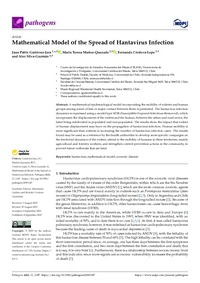Mathematical model of the spread of hantavirus infection
Autor
Gutiérrez-Jara, Juan Pablo
Muñoz-Quezada, María Teresa
Silva-Guzmán, Alex
Fecha
2023Resumen
A mathematical epidemiological model incorporating the mobility of rodents and human groups among zones of less or major contact between them is presented. The hantavirus infection dynamics is expressed using a model type SEIR (Susceptible-Exposed-Infectious-Removed), which incorporates the displacement of the rodent and the human, between the urban and rural sector, the latter being subdivided in populated and non-populated. The results show the impact that rodent or human displacement may have on the propagation of hantavirus infection. Human mobility is more significant than rodents in increasing the number of hantavirus infection cases. The results found may be used as a reference by the health authorities to develop more specific campaigns on the territorial dynamics of the rodent, attend to the mobility of humans in these territories, mainly agricultural and forestry workers, and strengthen control-prevention actions in the community, to prevent future outbreaks that are fatal.
Fuente
Pathogens, 12(9), 1147Link de Acceso
Click aquí para ver el documentoIdentificador DOI
doi.org/10.3390/pathogens12091147Colecciones
La publicación tiene asociados los siguientes ficheros de licencia:



